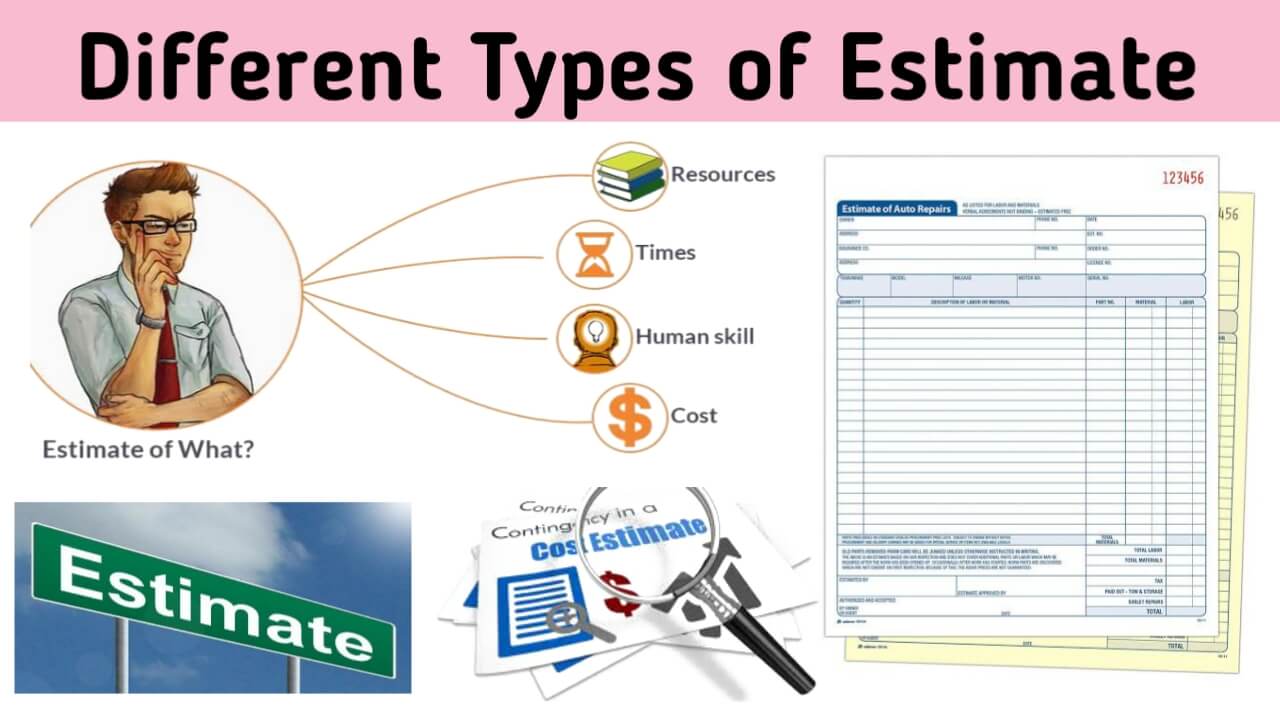In this web we Explain What is estimate, estimating and, costing? data required for preparing estimate, different types of estimates, approximate estimate, detailed estimates, purpose of estimates, skills required for estimator and duties of estimator and so more.
Table of Contents
Estimate
What is Estimate:
Before starting any construction, estimate the potential cost for the construction, how many materials will be required, how much labor will be spent. Forecast of material, labor, and the cost is done which is called estimate.
What is Estimating:
The act of making an Estimate is called Estimating.
What is Costing:
After knowing the amount and price of various items for any construction, the act of determining how much cost will be spent on the construction is called costing.
Data required for making an estimate:
The following information is required to estimate any construction.
- Plans, elevations, sections
- Specifications
- Item rates
1. Plans, elevations, sections:
Determining the quantity of different construction items based on the map.
2.Specifications:
Specifications provide information on the quality of materials used in construction and workmanship. The cost of construction increases if the specification is strict.
3. Item rates:
The cost of an item = the amount of an item × the price of an item.
The price depends on the following.
- Cost of goods
- Transportation cost
- Labor cost
- Overhead charges
- Machinery cost
- Contractor’s profit, etc.
Different Types of estimates:
There are two main types of estimates.
- Approximate estimate
- Detailed estimate

1. Approximate estimate:
Meaning of Approximate estimate
It is also called Preliminary estimate or Rough estimate. A rough estimate is made before making a detailed estimate of any construction. Approximate estimate are made based on information from other buildings in the same area as the one to which the estimate is to be made.
Purposes of preparing approximate estimate:
The objectives of making an approximate estimate are as follows.
- To do a preliminary study of the project
- Administrative approval
- To check the fairness of the investment
- Obtaining a loan from a bank
- Insurance
- Tax
- Rent
1. To do a preliminary study of the project:
From the approximate estimate to know how much the project will cost, how much material will be required, how many labourers will be required, how many and what kind of machinery will be needed so know whether it is worth doing project or not.
2. Administrative approval:
Before starting construction in a government account, administrative approval is sought for the project for which an approximate estimate is required.
3. To check the fairness of the investment:
How much will be spent for the project and how much will be returned from the completion of the project is calculated from the approximate estimate. The project is undertaken only if the return is more than 6% of the investment.
4. Obtaining a loan from a bank:
An approximate estimate of potential construction is required to obtain a loan from a bank.
5. Insurance:
The sum insured of a property is determined from its approximate estimate.
6. Tax:
Approximate estimate are required to determine home tax, property tax, etc.
7. Rent:
When the government rents a house, office or other purpose, the rent is determined from the approximate estimate of the house.
Detailed estimate:
Meaning of detailed estimate
Detailed estimate is the estimate prepared accurately from the plan, elevation, section of construction. In it, a certain amount is calculated from the length, width and height of each item. Multiplying these ones by its price gives the cost. The total cost is, added to the cost of all the items.
3 to 5% of the total cost thus obtained is added for contingencies. Also An amount of 2% is added for work charged establishment. The work charged establishment includes the salaries of supervisors, watchmen.
Purposes of preparing detailed estimate:
- To prepare tender for award of contract.
- To verify the tender of contractor.
- To pay the contractor’s bills.
- To provide ongoing work guidance.
- To Control on ongoing work.
- To fill tender for taking contract, etc.
Different Types of detailed estimates:
The different types of detailed estimate are as follows:
- Engineer’s estimate
- Contractor’s estimate
- Revised estimate
- Reduced estimate
- Supplementary estimate
- Annual repair estimate
- Special repair estimate
- Final estimate
1. Engineer’s Estimate:
This types of estimates is made by the engineer. Its objectives to obtain technical approval of the work. To prepare tender for awarding contract. Etc.
2. Contractor’s estimate:
This types of estimates is prepared by the contractor. Its objectives to fill the tender of the work.
3. Revised Estimate:
When a new estimate is created by revising a detailed estimate, it is called a revised estimate. A revised estimate is made in the following circumstances.
If the cost of the work exceeds 5% of the approved estimate.
If the cost of the work exceeds 10% of the amount approved by the administration. Significant changes have been made to the original proposal.
4. Reduced Estimate:
Often the contractor pays less for the item and the tender goes down by more than 10% of the estimated amount. In such circumstances a reduced estimate is made.
5. Supplemental Estimates:
While construction is in progress, some additional works need to be done which are not included in the original estimate. For such work another separate estimate is made and approval is sought from the competent authority. Such an estimate is called a supplementary estimate.
6. Estimate for Annual Repair:
In the government account, it is repaired every year for the maintenance of government constructions under the account. Such an estimate is called an annual repair estimate. These types of works include whitewashing, potholes, asphalt, etc.
7. Estimates for special repairs:
Construction is often damaged by natural events such as heavy rains, floods, earthquakes, fires, hurricanes, etc. Approval is sought for such repairs by making a separate estimate.
8. Final Estimate:
After the work is completed, the engineer makes an estimate based on the amount of work actually done and the price indicated in the tender, which is called the final estimate.
Skills of good estimator:
- He should be able to read construction drawings i.e. plans, elevations, sections etc.
- He should have construction experience.
- He should have knowledge of construction rules and principles.
- He should know the price of all the materials used for construction.
- The estimator should know what type and how much labour will be required for the construction.
- He should know the wage rate.
- He should have knowledge of how to measure various construction items.
- He should have knowledge of mathematics, geometry as well as trigonometry.
- He should have good general knowledge.
- He must have foresight and imagination.
Duties of a quantity surveyor or estimator
The main duties are as follows:
- Making an estimate
- Writing specific details
- Surveying the land and building
- Performing price Analysis
- Setting of final accounts
- Supervision of engineering constructions and making construction schedule (work execution schedule)
- Acting as arbitrator
- Assessing property
- Advise the architect and local authorities about the estimated cost of construction and its construction.
Reasons for actual cost exceeding estimated cost:
The actual cost of construction exceeds the estimated cost for the following reasons:
- Insufficient care has been taken in making the estimate.
- Prices of goods and labor have gone up after making the estimate.
- Some items are left to be included while making the estimate.
- Modified the design during construction
- Increased depth of foundation during construction.
Different types of estimates Pdf download
Also read:
- Total quality management – definition, principals, concepts
- What is Timbering? importance of timbering, methods of timbering.

I am a Professional Civil & Structural Engineer having more than 4 years of experience in Engineering, Procurement and Construction industry. Here i sharing the latest updates of EPC Projects and Construction News.


